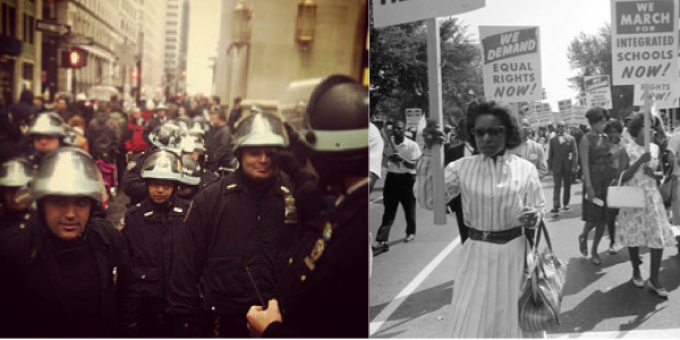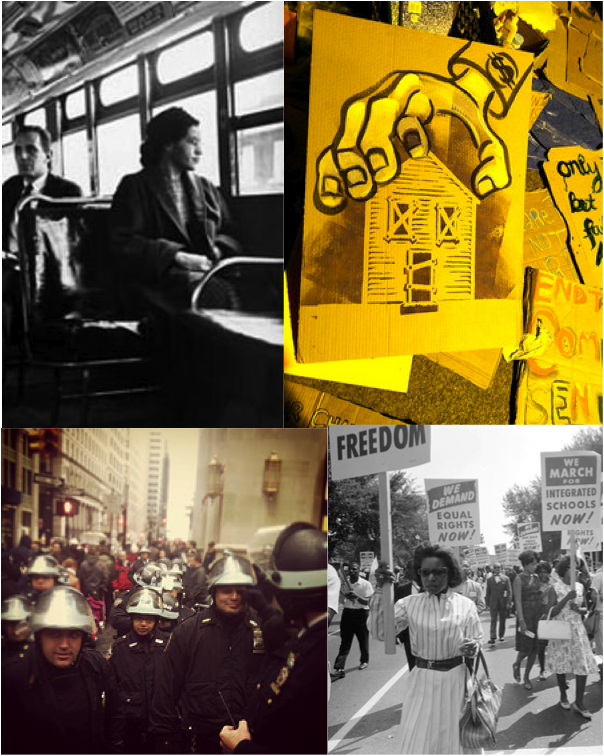
At the close of another hotly contested campaign season, politics seems to me like a sport. We have been inundated with commercials, bumper stickers, debates, and speeches. Fans have flaunted their allegiances while those at the top tried to carve out stances that would best appeal to particular demographics. Is it worth it? Does it really matter? What, if anything, really changes because of all this?
These, of course, are abstract, big-thinking, sociological kinds of questions. But if I remain uncertain about the answers, there is one thing that is clearly at stake in all of this: power. So, what is power? How is it achieved, exercised, and legitimated?
We in the social sciences typically think of power as persuasiveness, the ability to get what one wants—this is the essence of the classic definition attributed to Max Weber, and it’s commonly applied across a host of institutional spheres and interactions, from political parties to the power of consumers. But this view is a bit too simplistic—it obscures power’s fundamentally structural, cultural, and relational nature. This is to say, power is too often thought of as something that a particular leader or party has, rather than something rooted in institutional practices, cultural supports, and alternative pathways outside the usual political apparatus.
The problem of power, then, is a prime blind spot; the core, lower-level topics of political science—like individual voting behavior, party politics and alignments, and election outcomes—can direct us away from larger questions about the ends toward which political influence is directed. Sociology is uniquely equipped to look beyond the usual veneer of power, unpack the myths that reinforce it, and see the relational foundations upon which it ultimately rests. A sociological view indeed provides a much-needed corrective, offering a unique glimpse through the myths that veil power’s resilience, uses, and limits.The Structured Nature of Power
 As both classic scholars like C. Wright Mills and contemporary sociologists like Cecilia Ridgeway and Lynn Smith-Lovin have made clear, power derives from historically and culturally proscribed statuses (such as race and gender) and organizational and institutional positioning (e.g., manager, politician, school administrator). Power is more complex than that, though, as institutional, organizational, and bureaucratic structures confer greater or lesser leverage depending on position. Those of lower status are constrained to playing by the rules much of the time, while those in higher positions might be able to create or use even seemingly neutral rules in self-beneficial ways. Consider how tax codes, exam criteria for college admissions, penalties surrounding “suite” versus “street crimes,” and a bifurcated health care system benefit the already powerful while creating vulnerabilities and diminishing the power of others. Such arrangements highlight a key sociological insight: Culturally proscribed statuses and positions shape power and how that power is enabled or constrained by structure.
As both classic scholars like C. Wright Mills and contemporary sociologists like Cecilia Ridgeway and Lynn Smith-Lovin have made clear, power derives from historically and culturally proscribed statuses (such as race and gender) and organizational and institutional positioning (e.g., manager, politician, school administrator). Power is more complex than that, though, as institutional, organizational, and bureaucratic structures confer greater or lesser leverage depending on position. Those of lower status are constrained to playing by the rules much of the time, while those in higher positions might be able to create or use even seemingly neutral rules in self-beneficial ways. Consider how tax codes, exam criteria for college admissions, penalties surrounding “suite” versus “street crimes,” and a bifurcated health care system benefit the already powerful while creating vulnerabilities and diminishing the power of others. Such arrangements highlight a key sociological insight: Culturally proscribed statuses and positions shape power and how that power is enabled or constrained by structure.
Politics and elections, even in an ostensibly democratic system, are not impervious to the structural dynamics of power. One commonly hears, for instance, of the ways in which citizens wield their power through votes. Yet, voting is defined by the structural dictates of law and can be subject to legal or informational manipulation—for instance, gerrymandering might dissipate electoral power or misinformation might create real or perceived limitations to exercising the vote. Perhaps more importantly, the very political options we have—the candidates, parties, and political agendas we choose from—are considerably limited by, even beholden to, wider interests and influences. Structure clearly constrains access, choices, agendas, and actual political decision making and policy, regardless of citizens’ desires. Further, those in privileged positions will, by and large, hold the structural and institutional tools to reinforce prevailing power hierarchies.
The role of structure in bolstering power differentials is equally true of other institutional realms. Employees, for instance, are typically bound to procedural manuals, existing technological controls, or the speed of machinery, and they have fewer protections than they’ve had in the past. Supervisors can invoke (or not invoke) elements of authority and sanctioning like hiring, firing, demoting, and promoting, often with little repercussion. This is particularly true when shielded by legal precedence and financial advantage (that is, laws like corporate personhood protect many in powerful positions in the corporate world and, if they are challenged, money can allow for a great advantage in the courtroom). A similar case can be made for medical access, where power to obtain treatment is conditioned by resources, rules, and social safety nets dictated from by government officials, insurance companies, and the pharmaceutical industry. Even medical practitioners are increasingly constrained by structures leveraged by even more influential actors and entities. In these regards, power is vested in the system—or, to be more precise, in how social relations are structured and maintained within institutional and organizational contexts.
That powerful actors have the capacity to create or invoke structure in their own interests while the less powerful are more constrained is an important sociological point, yet it is typically hidden by our everyday understandings of how organizations and institutions operate. Indeed, we tend to see contemporary structures and rules as more or less bureaucratic, rational, and neutral. And, to be sure, they are presented that way. Yet, significant inequalities exist across most institutional domains, including politics. Consider, for instance, who is represented, who has voice, who benefits from policies, and which agendas reach the table.

In one clear example, in recent years, agents of large and powerful financial institutions manipulated the stock market and gambled on high-risk mortgages for the sake of massive personal and institutional financial gains. To prevent more devastating losses to shareholders and the public, these companies were “bailed out” by the federal government, with some bailout money going toward financial bonuses for CEOs. Few were prosecuted for mismanagement, and fewer still were characterized as criminals, to the outrage of an electorate that has seen its social safety nets evaporate, housing values deteriorate, retirement accounts dwindle, reproductive rights attacked, job prospects collapse, and the possibility of universal health care taken off the table. “Power begets power” rings apparent; the less powerful were left paying the bill.
Such a disconnect, I would submit, is due to the fact that we tend not to see large-scale abuses as unjust exercises of power so much as the unfortunate results of an amorphous “bad social system.” What we forget—or choose to overlook—is that this “unfortunately bad system” benefits those who constructed and control it in the first place. Equally misguided is a focus on the microlevel: equating misconduct with “a few bad apples.” That view ascribes abuses of power to individual defect, obfuscating its structural and systemic character. Instead, we must return to the fact that structure bolsters power for some and mitigates it for others.
Cultural Scaffolding and the Legitimation of Power
Power relations and the structures that support them, according to classic and more contemporary sociological work by scholars including Antonio Gramsci, Pierre Bourdieu, and L. Richard Della Fave, are typically buttressed by what I call “cultural scaffolding”—that is, values and belief systems that portray power and its use as reasonable and legitimate. Popular portrayals, in fact, remain largely loyal to neutral assumptions about how power operates, rarely question the legitimacy of those in power or the cultural symbolism they invoke, and often seem unaware of the cultural foundations that reinforce unequal power relations in organizational, institutional, and political life. The sociological focus on cultural scaffolding forces attention toward the ways in which power differentials and the exercise of power itself are legitimated—made to seem reasonable, just, rational, and even natural.
Language and symbolism are important in these regards, especially when it comes to symbolic vilification. Symbolic vilification is the process whereby the powerful scapegoat opponents or less powerful actors by deeming them less worthy, problematic, or even dangerous. When this occurs, it is easier to maintain power by creating fear, reify inequality through exclusion, apply punitive sanctions and control policies, or even invoke violence toward subordinated groups, as Erich Goode and Nachman Ben-Yehuda, as well as Joshua Guetzkow, have observed. A second, often simultaneous process entails symbolic amplification, which occurs when actors imbue and elevate certain elements of cultural, institutional/organizational, and political life to a place of almost sacred reverence. One might consider broadly constructed cultural values (say, freedom, democracy, and equality) in this light, but also more institutionally and organizationally specific processes like educational choice, religious piety, or “family values.”All actors, of course, can invoke such symbols. Social movements typically do so in an effort to galvanize commitment, participation, and public support, find scholars like David A. Snow and Robert D. Benford. Importantly, though, symbolic amplification is also commonly mobilized in defense of institutional power, practices, and privilege. That is, symbolic amplification can be used in conservative ways that defend the status quo.
Sociologists may seem unique in our emphasis on culture and the dynamics of “legitimation,” but political parties and candidates are well aware of the effects. They work incredibly hard to frame issues in a manner consistent with the identities and value systems of their targeted demographic voting groups. This is easily witnessed in, for example, the political use of the terms democracy and freedom relative to the vilification of immigrants, minorities, and labor unions.

To further clarify, I offer two other brief examples. First, there is American public education, which has witnessed dramatic changes over the last decade. This change has come under the rubric of educational “competition” and “accountability.” States and advocates, hoping to garner public support and push through various alternatives (voucher systems, charter schools, etc.) quickly mimicked one another in amplifying these values, while simultaneously blaming teachers, teacher unions, and tenure-based systems for “poorly performing schools.” Simultaneous amplification and vilification, in this case, provided the cultural scaffolding to legitimate policy changes—changes that have had greater benefits for already advantaged populations and have led to increasing levels of segregation, as documented by contemporary scholars Gary Orfield and Linda A. Renzulli.
My second example comes from the years I spent examining workplace discrimination. In that research, I did find some examples of “bad apples” in otherwise good environments, yet in the vast majority of cases, employers used otherwise neutral bureaucratic rules and procedures to systematically fire, demote, not promote, and harass minority, female, and aging employees. These employers defended their actions by simultaneously amplifying claims of merit, business interest, and neutrality (often pointing to official bureaucratic rules) while also vilifying victims as unstable, unreliable, and problematic. The use of ostensibly neutral rules and structure by powerful actors was clear, as was the cultural scaffolding that legitimated their discriminatory conduct.
Culture and legitimation are undoubtedly elemental to understanding power within any institutional or organizational context. Cultural values and symbolism are invoked by those in power or vying for power, sometimes to manipulate, sometimes to blur complex issues, and certainly to bolster allegiance and an image of fairness, neutrality, and trustworthiness. Such processes also reduce the chances that less powerful actors, be they in politics or some other institutional domain, will recognize or act upon alternatives, abuses, or the inequalities that often result.
Relations of Power and Challenge
Given structural and cultural advantages, one might simply conclude that the powerful are secure. They may be, to some degree, given the complex conjuncture of structure and culture that privileges the status quo. But sociological luminary Frances Fox Piven reminds us that history reveals important caveats and insights regarding the fundamentally relational nature of power. Power is, after all, ultimately dependent on the perceptions of and compliance by the population at large. Recognizing this, Piven explains, can reveal points where power might be effectively challenged—or at least held in check.
One such opening is found in the fit between official decrees, supposed goals, and the invoking of valued cultural symbols with actual policies and practice. Indeed, the alignment of official claims and practice should be a core focal point for sociologists, policymakers, and those on the legal-judicial and activist fronts. Elite vulnerability to challenge may emerge if efforts at vilification do not resonate, cannot be squared with the facts, or meet with some form of backlash or when powerful actors’ behaviors are revealed as hypocritical. In these situations, individual and collective action can pose a counterbalance to current power. Individuals, of course, have always resisted inequality and power relations in everyday life, be it through direct confrontation, silent resistance, compliance, or the use of more formal channels such as grievance procedures or legal disputes. As I have noted, however, the playing field is quite uneven. By virtue of bureaucratic access, positions, and resources, those in power have both culturally proscribed authority and a better chance to create and implement the rules by which we are all to play. Such advantages confer greater structural and cultural leverage.Collective action is another important counterweight to standing power. The success of movements often depends on the degree to which the action explicitly challenges (and succeeds at challenging) the structural and cultural bases of power. Certain movements (like the Civil Rights Movement of the 1960s) have been effective by employing tactics of civil disobedience—disruptive tactics that directly challenge institutional and structural dictates, often while making moral claims, in order to bring attention to power imbalances. Most contemporary social movements choose instead to work within existing institutional and cultural structures, though this blunts movements’ impact by constraining their actions to those that are not disruptive. Some recent exceptions to this pattern include the Arab Spring, which directly defied political control and authority, and waves of same-sex marriage ceremonies orchestrated by ministers in the United States, despite their illegality at the state level. In each case, structural and cultural underpinnings were directly confronted.

Still, most contemporary social movement activities might be best described as legal and organized consciousness-raising activities. These efforts may be effective, but likely only to the extent that the message resonates widely enough that power holders are forced to cater to a sizeable voting block. The Occupy Wall Street Movement held this potential and certainly altered to some extent the language the powerful used in their appeals to the broader voting public. It is unclear, however, whether the ideas and words of movements—even if adopted into the framing and rhetoric of the powerful—will result in systemic, structural transformations (especially, as in the case of Occupy, as the movement declines in participation and visibility). Effective challenge, whether individual or collective, must confront the structural and cultural foundations that sustain the bases and practices of power.
Conclusion
Grounded in the study of multiple institutional and organizational arenas, sociological insights on power can and should be extended to our understanding of politics. This includes the politics occurring right before our eyes in local and national races and as policies are implemented on-the-ground, but also general conceptions of political power. Just the other day I began imagining similar processes as they must have occurred in ancient Rome. There goes Julius Caesar, I thought, making populist appeals for a fairer distribution of resources so as to galvanize his solitary power. And there, the Roman Senate, comprised of elites, appealing to the preservation of “democratic” governance. Surely the structural, cultural, and relational nature of power about which I have written were as relevant in the face of the inequalities and politics of power in ancient Rome as they are in contemporary China, the United States, and throughout the Middle East.
None of this, of course, is to suggest that there are not differences in the practice of power across historical and contemporary contexts or that there are no divergences between specific power holders or political parties. There certainly are. The extent of true change, however, lies in the ability to transform structure and culture in meaningful ways, and it is difficult to imagine that the source of fundamental transformation will emerge from power itself, vested as it is in established structural and cultural arrangements. Small differences between political actors and parties may be enough for the populace. Or, perhaps unforeseen movements will emerge to challenge, shake, or transform current power relations and the structural-cultural foundations that support them. I am certain of none of this. What I am sure of is that sociology provides the keenest and most in-depth tools through which to see, dissect, and understand how power, including that surrounding politics, operates.
Recommended Reading
Pierre Bourdieu. 1991. Language and Symbolic Power. In this classical work, Bourdieu captures and explains the essence of culture and language, along with the ways in which they create and solidify societal divides.
L. Richard Della Fave. 1986. “Toward an Explication of the Legitimation Process,” Social Forces. Provides sociological insight into the dynamics of legitimation as they relate to inequality and the possibilities of challenging power.
Joshua Guetzkow. 2010. “Beyond Deservingness: Congressional Discourse on Poverty, 1964-1996,” Annals of the American Academy of Political and Social Sciences. Presents important and direct analyses of how language and how the poor are framed precedes the construction and enactment of political policy.
Frances Fox Piven. 2008. “Can Power From Below Change the World?” American Sociological Review. In this presidential address to the American Sociological Association, Piven reminds the reader how and why power is never absolute and offers insight into the leverage less powerful actors might express.
Cecilia Ridgeway and Lynn Smith-Lovin. 1999. “The Gender System and Interaction,” Annual Review of Sociology. The authors provide an important overview of power as it relates to status, interaction, and structure relative to gender and inequality.

Comments 5
Jose R. Sanchez — December 28, 2012
I like this article a lot. I think you do a great service to remind people of how so many important and often used concepts, like power, go generally unexamined. We use it all the time without necessarily having much insight into what we are trying to say or what we imply. That happens more than most of us want to believe.
My own attempts to wrestle with these thorny issues with power can be found in the book Boricua Power. It does not strike radical new grounds. But it does try to build what I believe is a more coherent theory of how power gets created and disappears. It can be found at:
http://www.amazon.com/Boricua-Power-Political-History-Puerto/dp/0814798489/ref=sr_1_1?ie=UTF8&qid=1356621130&sr=8-1&keywords=boricua+power
Thank you again.
Vincent Roscigno — January 1, 2013
Thanks for the great feedback Jose. I just ordered your book and look forward to reading it!
Very Best,
VR
Friday Roundup: November 9, 2012 » The Editors' Desk — April 1, 2014
[…] “Power, Sociologically Speaking,” by Vincent J. Roscigno. In which the author reveals power’s institutional practices, cultural supports, and alternative routes. […]
Week Five – Critical Thinking — November 4, 2016
[…] Society Pages. 2012. Power Sociologically Speaking. [ONLINE] Available at: https://thesocietypages.org/specials/power/. [Accessed 4 November […]
Brenda Washington — November 9, 2017
I love this article myself. The part about the job discrimination and the way people in the position treat us because we are older in age. We still have to work too and survive. Most of them in power are evil and I'm not sorry to say, Its just going to get worse. I'll be glad when the good LORD return.